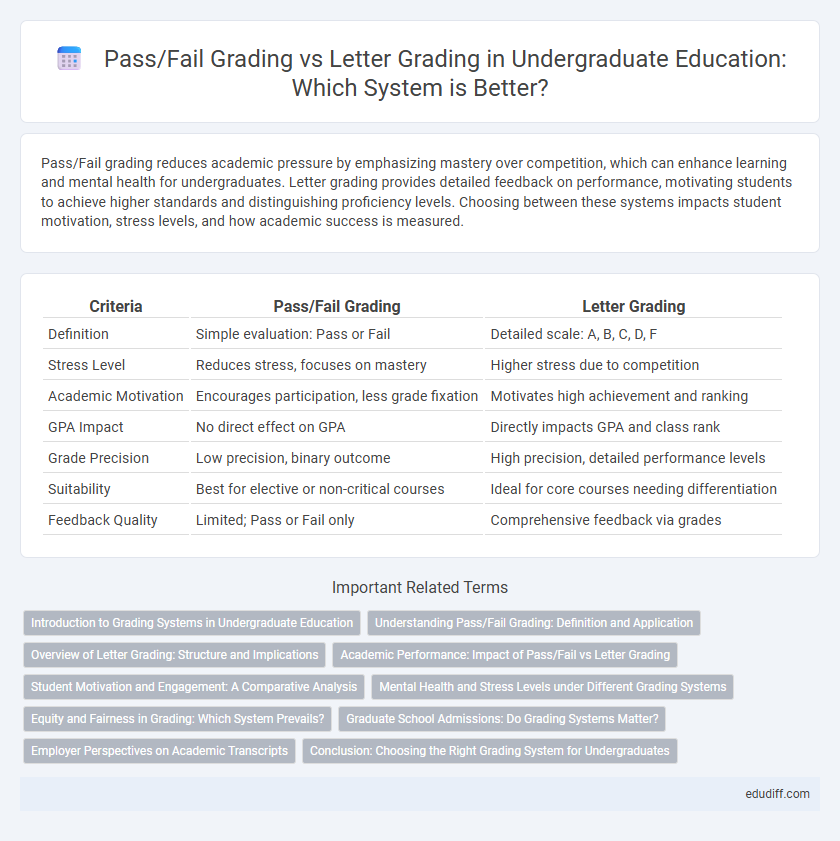Pass/Fail grading reduces academic pressure by emphasizing mastery over competition, which can enhance learning and mental health for undergraduates. Letter grading provides detailed feedback on performance, motivating students to achieve higher standards and distinguishing proficiency levels. Choosing between these systems impacts student motivation, stress levels, and how academic success is measured.
Table of Comparison
| Criteria | Pass/Fail Grading | Letter Grading |
|---|---|---|
| Definition | Simple evaluation: Pass or Fail | Detailed scale: A, B, C, D, F |
| Stress Level | Reduces stress, focuses on mastery | Higher stress due to competition |
| Academic Motivation | Encourages participation, less grade fixation | Motivates high achievement and ranking |
| GPA Impact | No direct effect on GPA | Directly impacts GPA and class rank |
| Grade Precision | Low precision, binary outcome | High precision, detailed performance levels |
| Suitability | Best for elective or non-critical courses | Ideal for core courses needing differentiation |
| Feedback Quality | Limited; Pass or Fail only | Comprehensive feedback via grades |
Introduction to Grading Systems in Undergraduate Education
Undergraduate education typically employs two primary grading systems: Pass/Fail and Letter Grading, each offering distinct advantages for assessing student performance. Pass/Fail grading simplifies evaluation by categorizing outcomes into two basic results, promoting risk-taking and reducing stress, while Letter Grading provides detailed differentiation of achievement through a scale from A to F, influencing GPA calculation and academic standing. Understanding these grading systems is crucial for students and educators when considering academic goals, course selection, and assessment strategies.
Understanding Pass/Fail Grading: Definition and Application
Pass/fail grading evaluates student performance by categorizing results as either satisfactory (pass) or unsatisfactory (fail), eliminating traditional letter grades like A, B, or C. This system reduces stress and encourages risk-taking in course selection, as the focus shifts from precise numeric scores to overall comprehension and competency. Typically utilized in undergraduate programs for elective or introductory courses, pass/fail grading emphasizes mastery of content over ranking students on a graded curve.
Overview of Letter Grading: Structure and Implications
Letter grading systems typically range from A to F, with each letter representing a specific range of percentage scores and corresponding to a grade point average (GPA) value used in academic evaluations. This structured approach allows for nuanced differentiation of student performance, impacting GPA calculation, academic honors, scholarship eligibility, and graduate school admissions. The implications of letter grading include increased motivation through clear performance benchmarks and the potential stress associated with competition for high grades.
Academic Performance: Impact of Pass/Fail vs Letter Grading
Pass/Fail grading systems often reduce stress and encourage risk-taking in course selection, potentially improving overall academic engagement and well-being. Letter grading provides precise performance indicators that motivate higher achievement and facilitate detailed feedback for academic improvement. Research indicates that while pass/fail grading can boost exploratory learning, letter grades better support long-term academic performance tracking and competitive postgraduate admissions.
Student Motivation and Engagement: A Comparative Analysis
Pass/Fail grading systems can increase student motivation by reducing anxiety associated with traditional letter grades, encouraging risk-taking and focus on learning rather than performance. In contrast, letter grading often drives competition and goal-oriented behavior, which may enhance engagement but also heighten stress levels. Studies indicate that while Pass/Fail enhances intrinsic motivation in subjects requiring creativity, letter grades better sustain engagement in quantitative disciplines requiring precision.
Mental Health and Stress Levels under Different Grading Systems
Pass/fail grading systems have been shown to reduce academic stress and anxiety among undergraduate students by eliminating the pressure to achieve specific letter grades. Studies indicate that mental health improves as students focus more on learning and mastery rather than competition and grade comparison. Conversely, letter grading often increases stress levels, contributing to burnout and negatively affecting psychological well-being.
Equity and Fairness in Grading: Which System Prevails?
Pass/Fail grading systems promote equity by reducing stress and minimizing bias linked to grade competition, fostering a more inclusive learning environment for diverse undergraduate populations. Letter grading offers detailed performance differentiation but can inadvertently disadvantage students from varied backgrounds due to implicit biases and disparities in access to resources. Studies show pass/fail models enhance fairness by focusing on mastery and reducing socio-economic impacts, yet letter grades remain crucial for academic and professional advancement, indicating the choice depends on balancing equity with evaluative precision.
Graduate School Admissions: Do Grading Systems Matter?
Graduate school admissions committees often evaluate applicants based on GPA and letter grades, as these provide nuanced insights into academic performance and rigor. Pass/fail grading systems may obscure distinctions between high and low achievement, potentially making it harder for admissions officers to assess applicant competitiveness. Research indicates that while some programs accommodate pass/fail transcripts, many graduate schools still prefer traditional letter grades for more precise evaluation.
Employer Perspectives on Academic Transcripts
Employers often view letter grading as a more detailed indicator of a candidate's academic performance, providing clear differentiation among levels of achievement compared to Pass/Fail grading. Pass/Fail transcripts may simplify evaluation, but they can obscure the distinction between high and average performance, potentially requiring employers to rely more on other qualifications or interviews. Consequently, while Pass/Fail grading reduces stress for students, employers frequently prefer letter grades for making more nuanced hiring decisions.
Conclusion: Choosing the Right Grading System for Undergraduates
Pass/fail grading reduces stress and encourages exploration by eliminating the pressure for high letter grades, benefiting students in challenging or unfamiliar courses. Letter grading provides detailed feedback on academic performance, which is crucial for internships, graduate school applications, and scholarship opportunities. Undergraduates should consider their personal goals, program requirements, and future plans to select the grading system that best supports their academic and professional success.
Pass/Fail Grading vs Letter Grading Infographic

 edudiff.com
edudiff.com